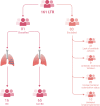Detection of Bacterial Colonization in Lung Transplant Recipients Using an Electronic Nose
- PMID: 37745948
- PMCID: PMC10513211
- DOI: 10.1097/TXD.0000000000001533
Detection of Bacterial Colonization in Lung Transplant Recipients Using an Electronic Nose
Abstract
Background: Bacterial colonization (BC) of the lower airways is common in lung transplant recipients (LTRs) and increases the risk of chronic lung allograft dysfunction. Diagnosis often requires bronchoscopy. Exhaled breath analysis using electronic nose (eNose) technology may noninvasively detect BC in LTRs. Therefore, we aimed to assess the diagnostic accuracy of an eNose to detect BC in LTRs.
Methods: We performed a cross-sectional analysis within a prospective, single-center cohort study assessing the diagnostic accuracy of detecting BC using eNose technology in LTRs. In the outpatient clinic, consecutive LTR eNose measurements were collected. We assessed and classified the eNose measurements for the presence of BC. Using supervised machine learning, the diagnostic accuracy of eNose for BC was assessed in a random training and validation set. Model performance was evaluated using receiver operating characteristic analysis.
Results: In total, 161 LTRs were included with 80 exclusions because of various reasons. Of the remaining 81 patients, 16 (20%) were classified as BC and 65 (80%) as non-BC. eNose-based classification of patients with and without BC provided an area under the curve of 0.82 in the training set and 0.97 in the validation set.
Conclusions: Exhaled breath analysis using eNose technology has the potential to noninvasively detect BC.
Copyright © 2023 The Author(s). Transplantation Direct. Published by Wolters Kluwer Health, Inc.
Conflict of interest statement
J.G.J.V.A. reports personal fees and nonfinancial support from Merck Sharp & Dohme and personal fees from Bristol Myers Squibb's, Boehringer Ingelheim, Amphera, Eli Lilly, Takeda, Bayer, Roche, and Astra Zeneca outside the submitted work. In addition, J.G.J.V.A. has a patent on allogenic tumor cell lysate licensed to Amphera, a patent combination immunotherapy in cancer pending, and a patent biomarker for immunotherapy pending. O.M. reports personal fees from Astra Zeneca, Boehringer Ingelheim, and Novartis outside the submitted work. In addition, O.M. is Chair of the Working Group Heart Failure of the Dutch Society of Cardiology. The other authors declare no conflicts of interest.
Figures



Similar articles
-
Diagnostic performance of electronic nose technology in chronic lung allograft dysfunction.J Heart Lung Transplant. 2023 Feb;42(2):236-245. doi: 10.1016/j.healun.2022.09.009. Epub 2022 Sep 20. J Heart Lung Transplant. 2023. PMID: 36283951
-
Diagnostic accuracy of eNose 'breathprints' for therapeutic drug monitoring of Tacrolimus trough levels in lung transplantation.J Breath Res. 2023 Sep 5;17(4). doi: 10.1088/1752-7163/acf066. J Breath Res. 2023. PMID: 37582348
-
The ability of an electronic nose to distinguish between complications in lung transplant recipients.Am J Transplant. 2025 Apr;25(4):804-813. doi: 10.1016/j.ajt.2024.11.009. Epub 2024 Nov 20. Am J Transplant. 2025. PMID: 39571751
-
The smell of lung disease: a review of the current status of electronic nose technology.Respir Res. 2021 Sep 17;22(1):246. doi: 10.1186/s12931-021-01835-4. Respir Res. 2021. PMID: 34535144 Free PMC article. Review.
-
Research progress of electronic nose technology in exhaled breath disease analysis.Microsyst Nanoeng. 2023 Oct 11;9:129. doi: 10.1038/s41378-023-00594-0. eCollection 2023. Microsyst Nanoeng. 2023. PMID: 37829158 Free PMC article. Review.
References
-
- Chambers DC, Cherikh WS, Harhay MO, et al. ; International Society for Heart and Lung Transplantation. The International Thoracic Organ Transplant Registry of the International Society for Heart and Lung Transplantation: thirty-sixth adult lung and heart-lung transplantation report—2019; focus theme: donor and recipient size match. J Heart Lung Transplant. 2019;38:1042–1055. - PMC - PubMed
-
- Blitzer D, Copeland H, Roe D, et al. . Long term survival after lung transplantation: a single center experience. J Card Surg. 2020;35:273–278. - PubMed
-
- Gottlieb J, Mattner F, Weissbrodt H, et al. . Impact of graft colonization with gram-negative bacteria after lung transplantation on the development of bronchiolitis obliterans syndrome in recipients with cystic fibrosis. Respir Med. 2009;103:743–749. - PubMed
LinkOut - more resources
Full Text Sources

